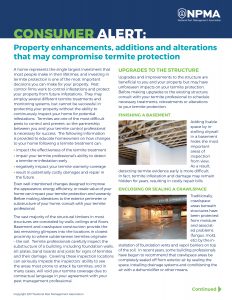After entering a structure, termites become even more difficult to detect when they hide behind drywall, carpets and other construction materials. When you inspect buildings with crawlspace or unfinished basement foundations, at least you have the advantage of being able to visually inspect bare foundation walls and the wooden sub-structure of the building.
Unfortunately, customers focused on increasing the energy efficiency of their homes can unwittingly make their home more vulnerable to termite infestation and damage. For example, spray foam insulation often covers the interior foundation walls, sill plate and header board — and sometimes the joists and subfloor, too. This makes it impossible to inspect the area for termites or signs of their damage. Termites tunnel through and under the insulation to gain access to wood hidden behind the foam.
How do you combat this? Alert your clients about the hazards associated with creating inaccessible areas with insulation or other coverings. The National Pest Management Association has created a consumer alert to help companies communicate how well-intended property enhancements, additions and alterations, including spray foam insulation, may affect insurance coverage, compromise termite warranty protection, and make it harder for inspectors to detect termites before they cause damage. You can download the bulletin through the association’s online Resource Center.
You can reach Dr. Jim Fredericks, VP of technical and regulatory affairs for the National Pest Management Association (NPMA), at jfredericks@pestworld.org.

Leave A Comment